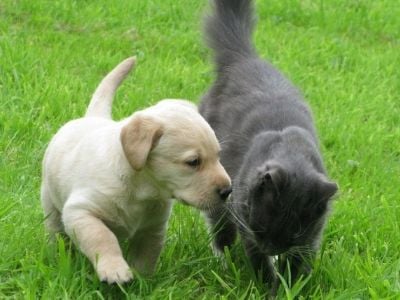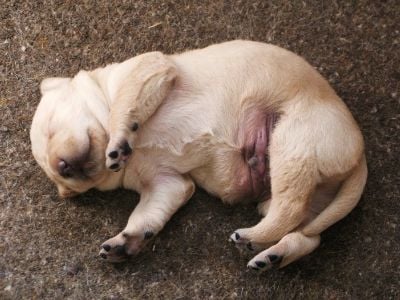Single Puppy Syndrome - Raising An 'Only Puppy'
Posted on

Back in 2012, my Labrador, Cira, had her first litter. Unfortunately, she suffered trauma in the womb, causing six of her seven puppies to be stillborn. She became a mother to a single puppy, Cosmo, and we both had a lot of learning to do. A single puppy doesn’t have the support, nor the competition, of his littermates, meaning there are actions you must take to ensure you raise a well-rounded, healthy puppy.
Check out TP Feeds All Life Stages Grain Free Beef with Superfood Mix to give your puppy the best start in life.
Problems During Whelping (Birth)
If only a single foetus is created following a successful mating, there are a couple of issues that could occur even before the puppy is born. Whelping doesn’t occur simply because a certain number of weeks have passed, it is instigated by the foetuses releasing a stress hormone as they have grown too large to be adequately nourished by the uterus. If there is only one puppy releasing this hormone, the level may not be sufficient enough to initiate the birthing process. If action is not taken in time, the puppy will die and become mummified. On occasion, the cervix may only partially open; this allows bacteria to enter the uterus and can cause the foetus inside to rot. Both of these scenarios also present a serious risk to the health of the dam (mother). If the puppy does manage to initiate whelping, the dam may well struggle to birth him naturally due to his increased size.

Lack of Bite Inhibition
A litter of puppies are constantly socialising and learning how to interact with their peers. One of the important things that puppies learn from each other is emotional control and the point at which their playful nip becomes an unacceptably painful bite. When puppies play they obviously use their teeth and claws, jumping on each other and chewing their brother/sister’s ears. If a puppy is too rough or bites too hard, their sibling will yelp and stop playing, or retaliate to put the offending puppy in his place. This exuberant playtime also helps the puppies’ muscles and coordination develop. Single puppies clearly don’t have any littermates to provide this interaction, they need you to be the substitute; playing with them, pushing them around a little bit, ‘yelping’ and ignoring them if they get too boisterous. You may need a high pain tolerance for this – puppy teeth and claws are needle-sharp and can be painful even when they’re relatively calm!

The ‘Spoilt Brat’ Complex
Another role of littermates is to teach each other that they can’t always have what they want whenever they want it. A single puppy can find frustration or any form of discipline very difficult to handle in later life due to this. For example, when you watch a litter of puppies feeding from the dam, you will see them pushing, shoving and clambering over each other to get to the ‘best’ teats. Pups will get pushed off teats whilst they’re feeding and will have to ‘fight’ their way back to the ‘milk bar’. Single puppies don’t have this issue; they can feed off any teat they like, and quite often will feed off several teats at every feed, without being disturbed. If they are allowed to continue with this lifestyle throughout their early weeks, they can potentially react aggressively in later life if their behaviour is ever corrected and can also be more difficult to train. However, again, there are small things that you can do that will make a world of difference; whilst your puppy is feeding, contrary to standard advice regarding adult dogs, fuss with the puppy, gently push them back and forth and occasionally knock them off the teat that they are feeding from, thus mimicking the action of his absent littermates.
Lack Of Warm Cuddles
As you will be aware if you’ve ever seen or bred a litter of puppies, they tend to all huddle together to sleep, keeping each other warm. A single puppy obviously doesn’t have this option. They will, of course, snuggle up with their mother instead but, particularly in the early days and weeks and depending on the time of year, you may wish to provide an alternative source of heat for whilst the dam is out on a walk or if she looks to be needing a little personal space occasionally. A heat lamp is a great option; this what I use with litters that require an artificial heat source. Alternatively, you could put a heat mat or hot water bottle underneath the bedding – ensuring that the area is not too hot and that you follow any instructions carefully on heat mats. I haven’t used these methods and certainly wouldn’t opt for them with a puppy that is old enough to be capable of chewing through any items placed in their sleeping area.

Puppy Fat And More
Clearly, with no competition for the milk supply, a single puppy is generally going to receive more than their fair share at each feed. My own single pup from several years ago was nicknamed (not by myself!) ‘the slug’, as he was a little blob of a puppy until he found his feet properly and burnt off the excess calories. This isn’t really something that can be avoided, other than physically removing the puppy from his dam and rationing his access to milk, which would do far more harm than good to the puppy and the dam’s wellbeing.
Slow Walkers
Be aware that if you have a single pup, they may well take slightly longer than usual to start walking due to this excess weight that they are carrying. This is usually simply a waiting game and a short-term problem. Obviously, if you are concerned or if the puppy is showing no signs of trying to walk after two weeks of age, you should always consult your veterinary surgeon.
The key to raising a single puppy is lots of interaction, both with humans (including children, who can be fantastic for puppy socialisation) and other puppies and young dogs as he grows.
Check out TP Feeds All Life Stages Grain Free Beef with Superfood Mix to give your puppy the best start in life.
Related Articles:
Swimmer Puppy Syndrome - It's Not The End Of The Road
Canine Elbow Dysplasia: X-Raying May Not Be The Answer - Guest Vet Blog

Add a comment: